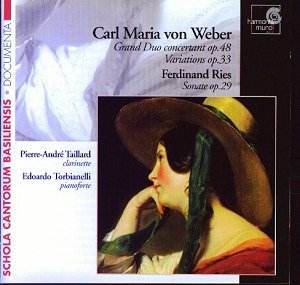First let me quote from the booklet cover blurb because
it is relevant: "The timbre of the clarinet is often considered
as the epitome of the romantic sound. But it is only when one hears
the period clarinet of the early nineteenth century that it becomes
possible to appreciate the full fascination of the instrument. In combination
with the outstanding Viennese fortepianos of the time, it produces hitherto
unheard-of blends of tone-colour." True, the exquisitely musical
playing of Pierre-André Taillard – his flawless technique and
control (with very little of the breathing sounds [except in the variations]
that mar so many woodwind chamber music recordings) and sensitivity
of expression make this recital a true pleasure. He is given robust
and very sympathetic support by Edoardo Torbianelli. The steeliness
of the fortepiano may at first seem a little disconcerting but it forms
a splendid foil to the lyricism of the clarinet.
The brilliant and technically demanding Weber Grand
Duo Concertant was composed in 1815 (the Andante and
Rondo) and the first movement in 1816. It was Weber’s last work
for the clarinet. The work is a dialogue of equals for both instruments.
The opening Allegro with its familiar tune is sometimes lively
and bright, sometimes wistfully yearning. The Andante has the
piano treading a slow march with long held melancholy chords on the
clarinet before the piano’s voice becomes increasingly passionate, even
operatic/melodramatic and the clarinet plaintive – all very theatrical
but most effective. The final Rondo allows the players’ virtuoso
capabilities full rein in the movement of light and shadow.
Weber’s ‘Seven Variations for clarinet and pianoforte
on a theme of Weber’s opera Silvana in B flat minor’ is an
earlier work, written in just one day – 14 December 1811 - in Prague,
for the famous clarinet virtuoso Heinrich Baermann. The theme, also
used by Weber for a set of violin variations, is taken from the clarinet
motif of the aria, "Wehe mir, es ist geschehen". It juxtaposes
a folk-song style, tenderness, fire and solemnity with great tunefulness.
The real discovery for this reviewer has been the Sonata
of Ferdinand Ries. Ries was a pupil of and was much influenced by
Beethoven. In fact Beethoven was of the opinion that Ries imitated him
too much. Robert Schumann felt that Ries was a composer "whose
remarkable originality was only overshadowed by that of Beethoven adding
that he thought many of Ries’s works occupied a "beautiful summit".
Schumann also thought he took a "sombre, discontented Byronic view
of the world." Byronic indeed, for here we have a dramatic, nay
melodramatic sonata, assertive and powerful, wild and passionate but
not without lyricism (the lovely slow movement is particularly noteworthy).
Like, the Weber works, its generous melodies and bravura virtuoso pages,
with many sinuous lines for the clarinet and fiery bombastic and thrilling
trill passages for the piano, impress strongly.
Sparkling performances and a thrilling Ries sonata
that has been a revelation for this reviewer add up to an irresistible
recital.
Ian Lace

![]() Pierre-André Taillard
(clarinet)
Pierre-André Taillard
(clarinet) ![]() HARMONIA MUNDI HMC 905254
[56:52]
HARMONIA MUNDI HMC 905254
[56:52]